Abstract
With a multiphase converter, the phase-shedding function dedicated to maximizing the power efficiency, in a manner that is dependent on the load current, is always provided by a centralized controller that induces a Single Point of Failure (SPOF). The objective of this study is to obtain a decentralized control approach to implement this function by removing any SPOF. The method consists of using identical local controllers, each associated with a converter phase, that communicate with each other in a daisy-chain structure. Instead of measuring the global output current to determine the optimal number of active phases required, each local controller measures its own leg current and takes a local decision based on threshold crossing management and inter-controller communications. Functional simulations are carried out on a 5-leg 12 V/1.2 V 60 W multiphase converter supplying a modern microcontroller. They demonstrate that the number of active phases is well adjusted, in a dynamic manner, depending on the load current level. Specific events such as load current inrush or the start-up sequence are analyzed to guarantee optimal transient responses. A maximum power efficiency tracking ability is also demonstrated. Finally, it is shown that this control strategy allows phase shedding to be implemented using as many phases as desired, in a modular manner, thereby avoiding any centralized processing.
1. Introduction
The popularity of multiphase converters for high load applications such as microprocessor power supplies has brought forward the need to improve the efficiency of the converter across a wide range of load currents, from a high level in normal operating mode towards a very light level during standby/sleep mode, for instance. The most popular technique used to achieve good performance is the phase add/drop technique, also known as phase shedding, which consists of adapting the number of active phases to always operate close to the maximum efficiency point of each phase for any load current. This technique has been quickly adopted for the improvement of the Voltage Regulator Modules (VRM) supplying modern microprocessors [1].
At first, applied through systems based on centralized control units, the benefits of phase shedding, regarding efficiency at light loads, were highlighted in [2], where a fundamental study of the method was described. Further improvements towards an optimal implementation of phase shedding were achieved with digital time-optimal control in [3], average current compensation across phases during phase shedding for fast transient in [4], as well as binary-weighted current sharing for precise coverage of the load range in [5].
Beyond the efficiency issue, various other interests in phase shedding were developed, with advantages for the power stage lifespan by using a rotating phase-shedding method in [6] and the system lifespan with current threshold adaptation to the input current and frequency variation in [7]. Power losses were also taken into account, as temperature variations were involved in the computation of current thresholds in [8].
The classic version of the phase-shedding implementation consists of measuring the load current and consequently adjusting the number of active phases to always maintain the power efficiency in an area of high values and to avoid an excessive decrease in the power efficiency at high and low currents. This method requires the number of active phases to be managed by a centralized controller, which is capable of deciding how many phases must operate at the same time. If the central controller fails, the function is lost. This represents a SPOF, which can be penalizing in many applications, such as automotive applications, for instance, which must meet rigorous standards [9,10]. In order to solve this problem and offer a fault-tolerant solution, a distributed/decentralized method of control was proposed in [11] and is described in detail in this paper. Such a modular approach will make it possible to lose part of the system if there is a failure while allowing the remaining elements (controllers and power devices) to reconfigure on-the-fly and ensure mission continuity.
Furthermore, by focusing on VRM-type applications, which use multiphase converters to power microprocessors [12,13], the system responses to very fast load transients (>800 A/μs) must be considered with great care [14]. Indeed, the operating modes of microprocessors generating fast transients require the power supply to provide high current in a very short time without penalizing the voltage regulation. In this context, the decentralized phase-shedding function must make it possible to manage particular operating modes for which all the phases must be simultaneously activated as quickly as possible.
In parallel with the development of these specific control techniques that are dedicated to optimizing the efficiency of the multiphase converter, other studies, focusing on the decentralized/modular control, have emerged to address the other control aspects of the multicellular converters. These methods address either the carrier interleaving [15,16,17,18,19], the current-sharing [20] or the voltage regulation [21,22,23,24]. A solution to control a multiphase converter in a fully decentralized manner was presented in [25]. Effective decentralized control strategies were also proposed in [26] and more recently in [27,28,29]. Now, a similar decentralized approach can be applied to the phase shedding in order to achieve full modularity for the multiphase converter control part, leading to greater flexibility, robustness and also a fault-tolerant capability.
Figure 1 describes the decentralized/modular implementation of the phase-shedding technique for multiphase converters proposed in this article. It is based on a daisy-chain configuration of local phase controllers, each communicating only with its close neighbors. Each local controller monitors its own phase current, compares it with the minimum and maximum current thresholds, and locally decides to remain active or not depending on the state of its close neighbors. This control strategy effectively optimizes the output efficiency across the full load range, as presented in [2], but in a decentralized manner.

Figure 1.
Decentralized phase-shedding control method using Local Controllers (LC) and daisy-chain inter-LC communications (VIi: the local current sensor output signal; Vref: the reference voltage; VD: the error-amplifier output voltage; Vout: the load voltage to regulate; GWU/Startup: two bits to handle heavy-load events). The status of the Local Controller is performed thanks to an input bit set to 1 (Master) or 0 (Slave).
In order to operate, the local controllers require several external signals provided either by a supervisor (startup/wakeup orders and the voltage reference Vref) or by sensors (phase currents Ii and the load voltage Vout). A Master/Slave bit determining their roles in the chain is also required. It should be noted that, in order to correctly operate during heavy-load events, such as the startup and wake-up of the load, as well as in reaction to a current inrush, the phase-shedding function has to be disabled automatically. Moreover, for very low load conditions, only one phase among the N will remain active and a so-called “low power” regulation mode will be used.
Figure 2 shows the several elements involved in the local controller. A current-mode voltage regulator is implemented. An error op-amp, activated only in the Master LC, equalizes the load voltage Vout with the reference signal Vref. It generates the signal VD, which is compared to the output signal VIi of the phase current sensor to produce the local PWM control signal. The signals and are generated, including a dead-time DT. A state-machine, dedicated to implementing the phase-shedding function, manages the status of the LC, i.e., enabled or not, depending on the parameter values and behavior of external signals. To perform the appropriate control of a multiphase converter, decentralized PWM signal interleaving and phase current balancing functions are included in the system. For the sake of clarity and to focus only on the phase-shedding part, these functions are not detailed in the figure. All information about their implementation can be found in [15,20] for the interleaving and the current balancing, respectively. All details about the operation of the state-machine are provided in Chapter 2. It should be noted that the color code of Figs. 1 and 2 is respected in order to help in the understanding of the control system (the inter-LC communications are shown in blue; the other connections are shown in red).
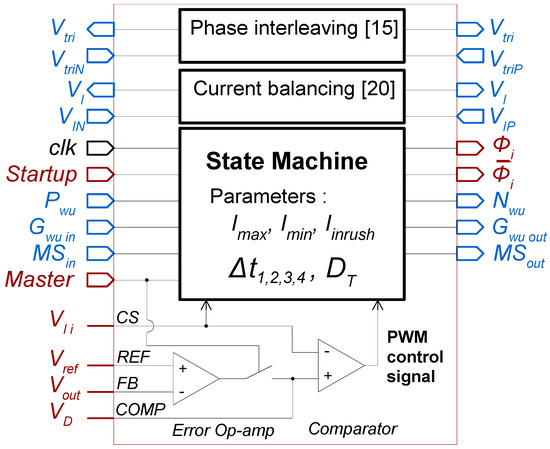
Figure 2.
Implementation of the Local Controller including a current-mode voltage regulator, phase interleaving and current balancing decentralized functions, and a state-machine dedicated to implementing the decentralized phase-shedding function (clk: clock signal for state-machine timing management; Vtri, VtriP, VtrNi: triangular carriers dedicated to phase interleaving; VI, VIP, VIN: phase current measurement dedicated to current balancing).
In Chapter 2, the principle and architecture of the local controller are detailed. Its internal logic functions are described, along with the threshold and timing considerations necessary to configure the system and ensure optimal operation.
In Chapter 3, transient simulations show the appropriate phase-shedding behavior across the full load current range. Slow and fast load transients are considered and analyzed.
2. Principle
The principle of the presented control method is based on the usage of N identical local controllers, each associated with one phase of the multiphase converter. Each controller manages its own state (active or not) depending on the current level of its phase and the state of its close neighbors. Then, inter-controller communications are proposed using a daisy-chain topology, current thresholds are set, and timing considerations for the phase activation or deactivation delays are analyzed.
Moreover, it should be noted that, in order to handle some specific cases of operation (start-up, high load current, and low power control mode), one of the local controllers has to be set as the master, with the others being slaves. The roles can be permuted if necessary; for instance, to address fault tolerance purposes.
2.1. Daisy-Chain Architecture
First, each controller is assigned a status, either by an external supervisor or by hardware: one is the Master (M) and the others are Slaves (S). While M always remains ON, regardless of the load current, Slaves turn on or off in a chaser sequence according to the load current.
In order to achieve decentralization of the phase shedding, each S observes its own phase current and uses current thresholds to decide to stay ON or not. The goal is to maintain each active phase within its maximum local efficiency range, as shown in Figure 3a. If the local phase inductor current increases and crosses Imax, the number of active phases should increase, as shown in Figure 3b; if it decreases and reaches Imin, the number should decrease, as shown in Figure 3c. This threshold crossing is monitored within each active local controller.
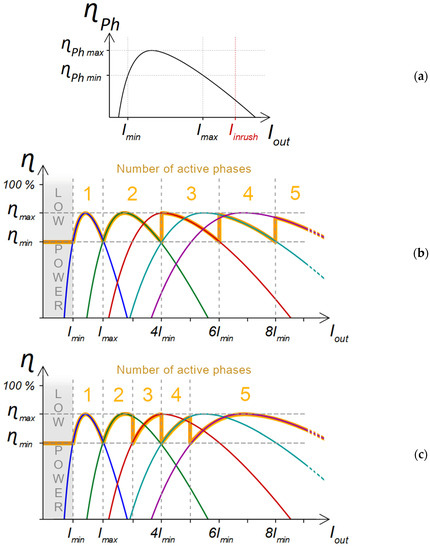
Figure 3.
Decentralized phase-shedding strategy: (a) minimum, maximum and inrush current threshold levels considering the efficiency of one independent phase ɳPh vs. the output load current Iout; (b) behavior of the global efficiency ɳ during a load current increase; (c) behavior of the global efficiency ɳ during a load current decrease (with Imax = 2 Imin). The independent efficiency responses of N-phase multiphase converters are shown with colored lines with N ranging from 1 to 5. The resulting converter efficiency, obtained using phase shedding, is shown in bright yellow.
In the case of a current threshold being crossed and because all phase currents are supposed to be equal in steady state, a sequencing of the local controllers is required to prevent all of the phases from simultaneously turning on or off. This is achieved for the incremental turn-on sequencing by using a Master/NotSlave signal chain () received by the local controllers and sent in the opposite direction to their neighbors, as shown in Figure 4. The master M sends = 1 and this signal flows through every inactive phase, each one also sending = 1 to their previous neighbor in the chain (they are called “bypassed”). The first active slave encountered by this signal can, therefore, acknowledge that it is leading the chain. It is allowed to use the current threshold crossings either to turn itself off (Imin crossing) or turn its next neighbor on (Imax crossing). From there, an active slave sends = 0, indicating to active slaves not leading the chain that they cannot change their states. The signal scheme sets local controllers in an orderly manner within the chain, with only the leading one allowed to take action.
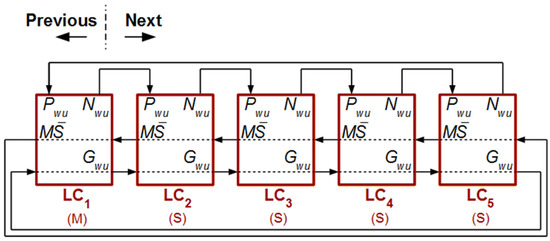
Figure 4.
Daisy-chain topology of the inter-LC communications aims to manage the enabling or disabling of a phase depending on the current level crossing (: the Master/Slave bit indicator; Gwu: the global wake-up order bit; Pwu: the previous wake-up bit; Nwu: the next wake-up bit).
Phase activation and deactivation sequences are presented in Figure 5. It is shown that if the low current threshold Imin is crossed, the leading active Slave turns off and bypasses itself to indicate to the previous one that it has become the leading slave. On the other hand, if the high current threshold Imax is crossed, the leading active Slave sends the Next Wake-up (Nwu) signal to activate its next closest neighbor.
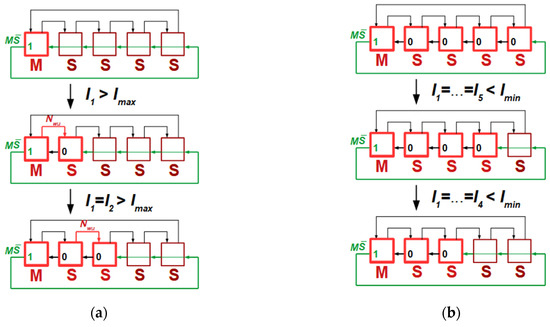
Figure 5.
LCs status depending on current threshold crossings: (a) enabling sequence for an increasing output current; (b) disabling sequence for a decreasing output current (M: the Master LC; S: a Slave LC; : the Master/Slave bit indicator intended to manage enabling/disabling sequences, such as chase sequences).
Two extreme cases can be highlighted: if all phases are already active, the number of active phases can only change by decreasing once Imin is crossed; if the Master is the only remaining active local controller and Imin is crossed, the Master goes into a Low-Power mode (LP), i.e., a voltage regulation mode based on a hysteretic control system such as Pulse Frequency Modulation (PFM) or Auto Pulse Skip Mode (APS), to maintain high efficiency even at lighter loads.
In addition to the standard operation of the system, which is based on the Imin and Imax current thresholds, specific events require all phases to become active at once: during system startup where a high output current is required to charge the output capacitor, during a heavy load activity already planned by the microprocessor, or during a heavy load current inrush. Two input bits, Startup and Global Wake-up (Gwu), allow the phase-shedding function to be disabled while activating all the Slaves, with the Master transmitting the Gwu signal to every Slave in a daisy-chain manner.
To implement this decentralized method, two state-machines are encoded in each local controller. Depending on the role played by the local controller, Master or Slave, the state-machine of Figure 6a or Figure 6b is used. It should be noted that, in the Master state-machine, the parameter PS indicates whether the phase shedding is enabled or not.
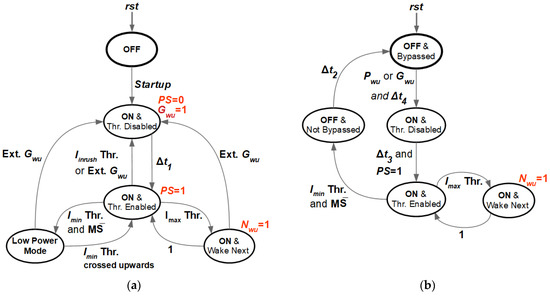
Figure 6.
The state-machine description depending on the role of the local controller: (a) the LC is the Master; (b) the LC is a Slave (the abbreviations Thr., rst, and Ext. stand for Threshold, Reset, and External, respectively).
However, in order to avoid instabilities during phase shedding, the principle of operation proposed requires additional considerations regarding the current threshold values and also the timing delays that are required during the activation/deactivation transitions.
2.2. Current Threshold Considerations
The previously described system, which is based on phase current monitoring and control logic units, does not guarantee the stability of phase shedding by itself. It is relevant to consider the stability issue during a deactivation sequence.
Indeed, one possible event is the decrease in the well-balanced phase currents of k active phases all reaching the Imin threshold at the same time (with k ≤ N). Then, the leading Slave turns off and the inductor current of its phase discharges toward 0 A through the low-side power switch body-diode. If the load conditions do not change after this deactivation event, i.e., the load current Iout remains equal to kImin, a new steady state is reached where the remaining k − 1 phases share the same portion of the load current. The ith phase currents Ii become:
where k is the number of active phases among the N phases of the converter.
Now, if the value of this local current exceeds the Imax threshold, the upper threshold is crossed, and an order to reactivate the previously turned-off phase is sent by the leading Slave. Then, the currents of the now k active phases will decrease again since no load event has occurred. This configuration is unstable. Hence, the condition to fulfill is the following:
The values of the steady-state phase currents depend on the number k of active phases. A worst case for Equation (2) is obtained with k = 2, i.e., the last remaining Slave turns off and Imin is handled twice by the Master, resulting in the stability condition:
A second threshold consideration concerns the dynamic response of the phase-shedding system during an unexpected fast load current surge. As presented in the previous section, phases turn on sequentially during a current increase sequence, therefore limiting the transient response speed to a high inrush current event. The designed solution consists of implementing a third threshold higher than Imax, called Iinrush (see Figure 3a).
This threshold is only considered by the Master and, as it is crossed, the Master issues a Gwu signal across the daisy-chain, temporarily turning on all phases and canceling the phase-shedding activity. The Iinrush threshold ensures the operational safety of the converter and leads to optimal efficiency during unforeseen strong load events.
2.3. Timing Considerations
Figure 6 shows transitions towards the “Wait for event” state, mainly current threshold crossing, which include delays Δt1, Δt2, Δt3 and Δt4. These delays must be implemented in order to create appropriate time shifts and to avoid instabilities.
Δt1: basic timing considerations concern the previously implemented Startup, Global Wake Up and Inrush events.
On the one hand, the duration of the Startup event, during which phase shedding remains deactivated, depends on the application and has to be estimated considering the time required to charge the output capacitor.
The duration of both the Gwu and Iinrush events, which are induced by external actions, has also to be designed according to load specifications and worst-case current surge transients.
Δt2: on the other hand, the increase and decrease rate of the local inductor current has an impact on the duration of transients during phase-shedding transitions.
Upon deactivation of a phase, the local inductor current decreases, over time, from Imin to 0 A. During this transient stage, the remaining active phases see their local currents increase while still potentially remaining below Imin. If the deactivated phase is bypassed too quickly and sets its previous neighbor as the leader of the chain, the latter would potentially deactivate itself as well. A chain reaction occurs, leading to a fast deactivation of all Slave phases.
To prevent this chain reaction, a delay between the phase deactivation and its bypassing is implemented. Its value corresponds to a full inductor discharge transient, and can be computed using simple design and application considerations:
where Rph is the ohmic resistive path of each phase (RON switches + inductor DCR + copper wires), and τ is the time constant L/Rph.
Unless the load current decreases further, which would create a valid sequential deactivation of phases, such a delay ensures that all remaining phases have time to cross the Imin threshold in an upwards direction before the leading one is allowed to deactivate itself.
Δt3: the activation of a phase is another potential source of instability. During the inductor charge transient of an activated phase from 0 A to Iout/k, as the local controller sees its local current below the Imin threshold, it will try to turn itself off.
A delay implemented between the moment of phase activation and the one when the phase is allowed to deactivate itself solves this instability issue. The worst case to consider is a phase current after charging in steady state right above the Imin threshold, i.e., the load current slightly higher than kImin. Hence, full charge has to be reached before deactivation is allowed:
This delay allows 99% of the steady-state current value to be reached before any further transition.
Δt4: the last delay consideration corresponds to the prevention of a re-wake event due to the large bandwidth voltage regulation loop. After a phase is deactivated, during a short transient stage, the voltage regulation loop might cause a temporary increase in the duty-cycle, inducing a local current overshoot across the remaining active phases. The phase current of the new leading Slave may, in turn, potentially cross the Imax threshold and cause it to send a Nwu signal to wake up the phase that has just been deactivated. To prevent this behavior, a delay has to be added between the deactivation of a phase and its ability to be reactivated, as shown in Figure 6b.
3. Simulation Results
This section presents the simulation results of the multiphase converter controlled by the proposed decentralized phase-shedding technique. Table 1 shows the parameters of the application, which requires a five-phase multiphase buck converter.

Table 1.
Parameters of the multiphase converter supplying a multicore 1.2 V/60 A microprocessor.
The voltage loop error amplifier is only active in the Master. Its output is connected to the node COMP in order to send the signal that allows computation of the local PWM signals to all remaining Slave Local Controllers [19].
The simulated load scenarios feature output current transients covering the converter’s entire current range, thus showing phase shedding during both a turn-on and a turn-off sequence (Figure 7).
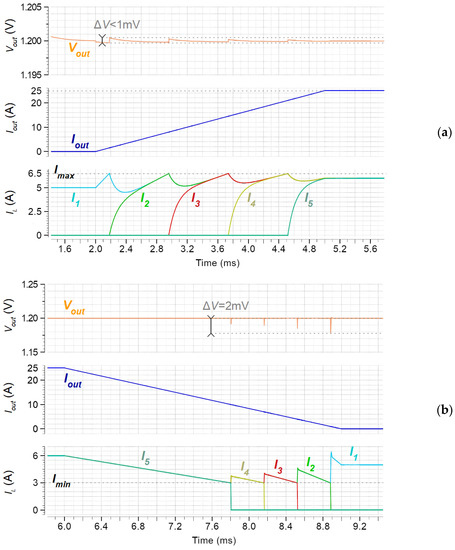
Figure 7.
Simulation of the converter response for a slow load transient: (a) load current rising from 0 to 25 A with LC turn-on sequence (Imax = 6.5 A); (b) load current falling from 25 to 0 A with LC turn-off sequence (Imin = 3 A).
An appropriate phase-shedding scheme is obtained in both cases with a smooth sequence set by Imax and Imin, as well as delays Δt3 and Δt4. Figure 7a shows the system response to a slow increase in the load current. Each time a phase’s local current reaches Imax = 6.5 A, a local wake-up signal is sent to the next phase by the leading Slave, thus increasing the number of active phases. The opposite behavior is observed in Figure 7b, where phases are successively deactivated each time Imin = 3 A is reached.
A secondary simulated scenario, shown in Figure 8, is the fast decrease in the load current. Delay Δt2 prevents a deactivation runaway during a fast decreasing load transient. Each phase sees its local current decrease below Imin, but this delay ensures a smooth transition from five phases to one phase by time-shifting the ability of a phase to turn itself off when it leads the chain.
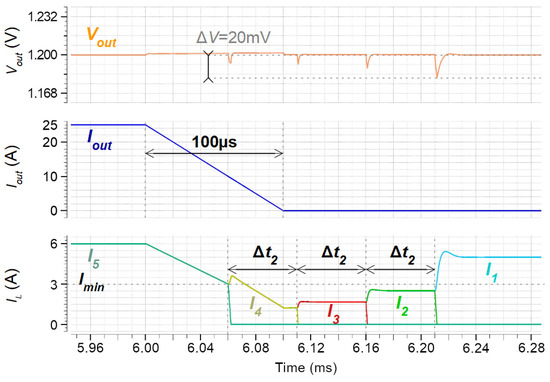
Figure 8.
Simulation of the converter response for a fast load transient falling from 25 to 0 A with shutdown preventing delay (Δt2 = 50 µs).
Finally, the effect of the third threshold Inrush used to handle a fast inrush current transient is illustrated in Figure 9. The natural incremental phase-shedding response to a strong inrush current, i.e., without threshold Inrush, is presented in Figure 9a. A potentially destructive 13 A overcurrent is observed in one phase and the system time response is 6 ms. In Figure 9b, the threshold Inrush is used. It generates a global wake-up signal Gwu that activates all phases instantaneously, overriding the phase-shedding function. The system transient is improved with only a 2 ms time response and a lower safe overcurrent is reached with only 8 A for the Master.
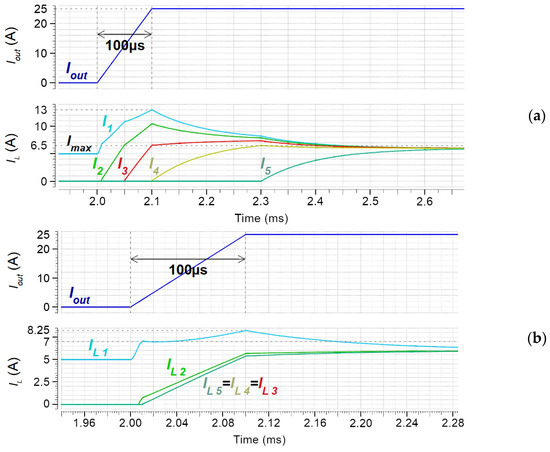
Figure 9.
Simulation of the converter response for a current inrush transient: (a) with Inrush threshold deactivated; (b) with Inrush threshold activated.
Figure 10 shows the simulation results for the power efficiency of the multiphase converter. Accurate models of 25 V/51 A 6 mΩ power MOSFET transistors are considered, as well as parasitic components (the ohmic path of the wire, the inductive effect, and the inter-wire capacitor). Figure 10a presents the power efficiency characteristics, which are dependent on the number of active phases when no phase shedding is considered. One can observe that the efficiency drastically decreases if only one phase is used. On the other hand, the higher the number of phases, the better the efficiency at high load current. However, the maximum efficiency level is shifted toward the right, as predicted by the theory. Figure 10b shows the behavior of the global efficiency of the converter when using the phase shedding for an increase in the load current. The phase sequence is similar to the one shown in Figure 7a. One can observe the efficiency waveform jump from one characteristic to the other when enabling the phases, then remaining in a tight range from 0.85 to 0.95. Figure 10c presents the same simulation but with a decreasing load current. Again, the phase disabling sequence, similar to the one in Figure 7b, allows the power efficiency to be limited in a tight range from 0.8 to 0.9. It should be noted that, first, high-frequency oscillations are mainly due to calculation approximations during transients, and second, because the low power mode at low current level is not simulated, the value at zero current level should not be considered.
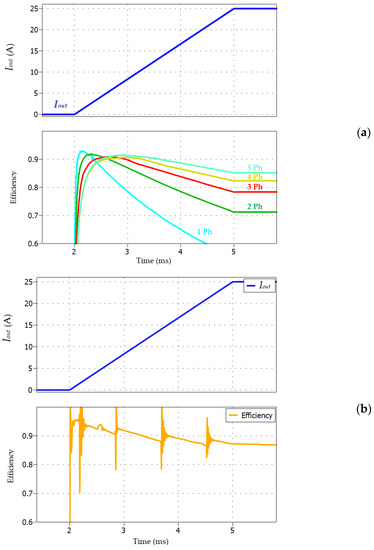
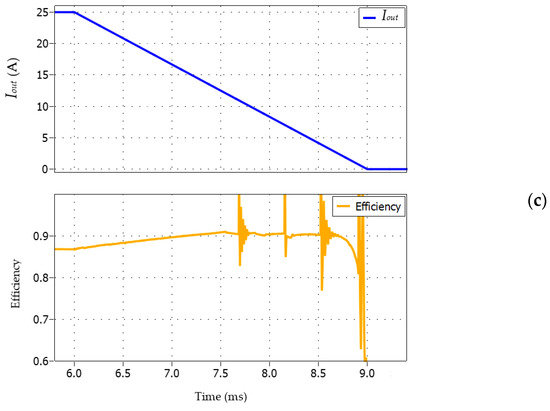
Figure 10.
Simulation of the multiphase converter power efficiency: (a) N-phase converter with phase shedding disabled, cases with N ranging from 1 to 5; (b) converter global efficiency during a load current increase with phase shedding enabled; (c) converter global efficiency during a load current decrease without phase shedding enabled.
4. Discussion
Functional safety is a primary concern in the automotive industry. To avoid the presence of SPOF, all the elements of the EV powertrain as well as the on-board computers are duplicated in high-end vehicles. For low-end or mid-range vehicles, it is not possible, for cost reduction reasons, to multiply all of the embedded components. In addition, modular approaches for the design of devices, such as multi-core processors or multiphase power supplies, offer new perspectives in terms of reconfiguration capabilities in cases of failure events. However, the power-supply controller should not be unique and centralized. The implementation of decentralized control techniques for the control of multiphase converters offers new application perspectives. If several functions have been decentralized in the past (interleaving, balancing, and regulation), the decentralization of the phase-shedding function represents a new stage of achievement. The results of our study, unprecedented in the scientific literature, will allow the design of new ASIL-D NXP products to address functional safety within the automotive sector.
5. Conclusions
A decentralized phase-shedding technique is presented. If the phase-shedding function dedicated to maximizing the power efficiency, in a manner that is dependent on the load current, is provided by a centralized controller, a Single Point of Failure is obtained in the system, meaning that it is not fault-tolerant. Thanks to this study, a decentralized control approach to implement this function by removing any SPOF has been established.
The decentralized control method consists of turning on or off a phase of the multiphase converter based on local decisions. Each phase monitors its own local current and compares it with the minimum and maximum predefined thresholds. Using local communications, depending on its own position in the chain and the state of the others, each phase consequently disables or enables its local power stage. For very low load currents, only one phase remains active. It then goes into low power mode to maximize the converter efficiency accordingly. In order to handle specific events such as a start-up sequence or inrush current requiring the fast activation of all the phases, additional functionalities are included in the local controllers. The protocol used to communicate between the cells is described, along with necessary design considerations of threshold and time shifting values.
Functional simulations are carried out on a 5-phase 12 V/1.2 V 60 W multiphase converter dedicated to supplying a microprocessor. It is observed that the number of active phases is well adjusted, in a dynamic manner, depending on the load current level, as expected. Specific events such as load current inrush or a start-up sequence are also simulated and show optimal transient responses.
Thus, the phase-shedding function is achieved using identical local controllers, making it possible to dispense with a central controller. It can be concluded that, first, using this decentralized control method, the number of phases that can be handled is not limited, and second, if the master status can be shared on a rotational basis, any SPOF is removed.
Author Contributions
Conceptualization, M.C. and L.H.; Formal analysis, M.M. and W.L.P.; Investigation, G.A., P.G. and D.F.; Supervision, M.C. and E.R.; Writing—original draft, M.C. and M.M.; writing—review and editing, M.C. All authors have read and agreed to the published version of the manuscript.
Funding
This research received no external funding.
Institutional Review Board Statement
Not applicable.
Informed Consent Statement
Not applicable.
Data Availability Statement
Not applicable.
Acknowledgments
The authors would like to acknowledge NXP Semiconductor, CNRS and Toulouse-INP for their support during the study.
Conflicts of Interest
The authors declare no conflict of interest.
References
- Redl, R.; Reizik, G. Power Management Solutions for Desktop and Mobile CPUs. In Analog Circuit Design; Springer: Boston, MA, USA, 2004; pp. 201–224. [Google Scholar]
- Zumel, P.; Fernandez, C.; De Castro, A.; Garcia, O. Efficiency improvement in multiphase converter by changing dynamically the number of phases. In Proceedings of the 37th IEEE Power Electronics Specialists Conference (PESC), Jeju, Korea, 18–22 June 2006; pp. 1–6. [Google Scholar]
- Costabeber, A.; Mattavelli, P.; Saggini, S. Digital time-optimal phase shedding in multiphase buck converters. IEEE Trans. Power Electron. 2010, 25, 2242–2247. [Google Scholar] [CrossRef]
- Teh, C.K.; Suzuki, A.; Yamada, M.; Hamada, M.; Unekawa, Y. 4.1 A 3-phase digitally controlled DC-DC converter with 88% ripple reduced 1-cycle phase adding/dropping scheme and 28% power saving CT/DT hybrid current control. In Proceedings of the IEEE International Solid-State Circuits Conference Digest of Technical Papers (ISSCC), San Francisco, CA, USA, 9–13 February 2014; pp. 78–79. [Google Scholar]
- Lukic, Z.; Zhao, Z.; Prodic, A.; Goder, D. Digital controller for multiphase DC-DC converters with logarithmic current sharing. In Proceedings of the IEEE Power Electronics Specialists Conference, Orlando, FL, USA, 17–21 June 2007; pp. 119–123. [Google Scholar]
- Ahn, Y.; Jeon, I.; Roh, J. A multiphase buck converter with a rotating phase-shedding scheme for efficient light-load control. IEEE J. Solid-State Circuits 2014, 49, 2673–2683. [Google Scholar] [CrossRef]
- Ruban, T.A.; Tadeparthy, P.; Aniruddhan, S.; Gakhar, V.; Venkateswaran, M. Optimal dynamic phase add/drop mechanism in multiphase DC-DC buck converters. In Proceedings of the IEEE Applied Power Electronics Conference and Exposition (APEC), Long Beach, CA, USA, 20–24 March 2016; pp. 1878–1881. [Google Scholar]
- Su, J.T.; Liu, C.W. A novel phase-shedding control scheme for improved light load efficiency of multiphase interleaved DC–DC converters. IEEE Trans. Power Electron. 2012, 28, 4742–4752. [Google Scholar] [CrossRef]
- Czerny, B.J.; D’Ambrosio, J.; Debouk, R. ISO 26262 Functional safety draft international standard for road vehicles: Background, Status, and Overview. Origins 2002, 9, 2003. [Google Scholar]
- Schumi, S.; Graf, A. Energy and supply concepts for automated driving. In Proceedings of the AmE 2018-Automotive Meets Electronics; 9th GMM-Symposium VDE, Dortmund, Germany, 7–8 March 2018; pp. 1–5. [Google Scholar]
- Hureau, L.; Cousineau, M.M.; Institut National Polytechnique de Toulouse INPT and NXP USA Inc. Multiphase dc to dc Converters with Phase Shedding, and Sub-Units and Methods Therefor. U.S. Patent Application 17/109,423, 3 June 2021. Available online: https://patents.google.com/patent/US20210167688A1/en (accessed on 15 August 2021).
- Zhou, X.; Wong, P.L.; Xu, P.; Lee, F.C.; Huang, A.Q. Investigation of candidate VRM topologies for future microprocessors. IEEE Trans. Power Electron. 2000, 15, 1172–1182. [Google Scholar] [CrossRef]
- Halivni, B.; Peretz, M.M. Digital controller for high-performance multiphase VRM with current balancing and near-ideal transient response. In Proceedings of the 2020 IEEE Applied Power Electronics Conference and Exposition (APEC), New Orleans, LA, USA, 15–19 March 2020; pp. 2206–2213. [Google Scholar]
- Su, Y.; Cheng, K.Y.B.; Wu, W. High-efficiency multiphase DC-DC converters for powering processors with turbo mode based on configurable current sharing ratios and intelligent phase management. In Proceedings of the 2017 IEEE Applied Power Electronics Conference and Exposition (APEC), Tampa, FL, USA, 26–30 March 2017; pp. 191–196. [Google Scholar]
- Cousineau, M.; Le Bolloch, M.; Bouhalli, N.; Sarraute, E.; Meynard, T. Triangular carrier self-alignment using modular approach for interleaved converter control. In Proceedings of the 2011 14th European Conference on Power Electronics and Applications, Birmingham, UK, 30 August–1 September 2011; pp. 1–10. [Google Scholar]
- Grégoire, L.A.; Cousineau, M.; Seleme, S.I., Jr.; Ladoux, P. Real-time simulation of interleaved converters with decentralized control. Renew. Energy Power Qual. J. 2016, 1, 15–64. [Google Scholar] [CrossRef]
- Phan, Q.D.; Gateau, G.; Nguyen, P.C.; Cousineau, M.; To, H.P.; Nguyen, B.A.; Veit, L.; De Milly, R.; Mannes-Hillesheim, M. A fast, decentralized, self-aligned carrier method for multicellular converters. Appl. Sci. 2021, 11, 137. [Google Scholar] [CrossRef]
- Phan, Q.D.; Gateau, G.; Cousineau, M.; Veit, L.; De Milly, R.; Mannes-Hillesheim, M. Ultra-fast decentralized self-aligned carrier principle for multiphase/multilevel converters. In Proceedings of the IEEE International Conference on Industrial Technology (ICIT), Buenos Aires, Argentina, 26–28 February 2020; pp. 517–522. [Google Scholar]
- Mannes-Hillesheim, M.; Cousineau, M.; Vivert, M.; Aulagnier, G.; Gateau, G. Eigendecomposition of a digital iterative decentralised interleaving for multicellular converters. Math. Comput. Simul. 2021, 184, 82–105. [Google Scholar] [CrossRef]
- Le Bolloch, M.; Cousineau, M.; Meynard, T. New masterless modular current-sharing technique for DC/DC parallel converters. In Proceedings of the 14th International Power Electronics and Motion Control Conference EPE-PEMC, Ohrid, Macedonia, 6–8 September 2010; pp. T3-73–T3-80. [Google Scholar]
- Cousineau, M.; Xiao, Z. Fully masterless control of parallel converter. In Proceedings of the 15th European Conference on Power Electronics and Applications (EPE), Lille, France, 2–6 September 2013; pp. 1–10. [Google Scholar]
- Xiao, Z.; Cousineau, M.; Sarraute, E.; Meynard, T. Modular control of parallel isolated micro-converters dedicated to conversion network. In Proceedings of the Twenty-Eighth Annual IEEE Applied Power Electronics Conference and Exposition (APEC), Long Beach, CA, USA, 17–21 March 2013; pp. 2555–2562. [Google Scholar]
- Cousineau, M.; Xiao, Z. Fully decentralized modular approach for parallel converter control. In Proceedings of the Twenty-Eighth Annual IEEE Applied Power Electronics Conference and Exposition (APEC), Long Beach, CA, USA, 17–21 March 2013; pp. 237–243. [Google Scholar]
- Cousineau, M.; Cougo, B. Interleaved converter with massive parallelization of high frequency GaN switching-cells using decentralized modular analog controller. In Proceedings of the IEEE Energy Conversion Congress and Exposition (ECCE), Montreal, QC, Canada, 20–24 September 2015; pp. 4343–4350. [Google Scholar]
- Cousineau, M. Modular Static Converters with Parallel or Series Architecture and Decentralized Modular Control (DMC). U.S. Patent WO/2014/005973, 28 March 2017. [Google Scholar]
- Cheng, Y.J.; Sng, E.K.K. A novel communication strategy for decentralized control of paralleled multi-inverter systems. IEEE Trans. Power Electron. 2006, 21, 148–156. [Google Scholar] [CrossRef]
- Ashourloo, M.; Namburi, V.R.; Piqué, G.V.; Pigott, J.; Bergveld, H.J.; El Sherif, A.; Trescases, O. Decentralized quasi-fixed-frequency control of multiphase interleaved hybrid Dickson converters for fault-tolerant automotive applications. IEEE Trans. Power Electron. 2019, 35, 7653–7663. [Google Scholar] [CrossRef]
- Heath, T.; Green, P.R.; Barnes, M.; Kong, D. Design, construction and testing of a modular multilevel converter with a distributed control architecture. In Proceedings of the 15th IET International Conference on AC and DC Power Transmission (ACDC), Coventry, UK, 5–7 February 2019. [Google Scholar]
- Nguyen, P.C.; Phan, Q.D. The development of decentralized space vector PWM method for multilevel multiphase converters. In Proceedings of the 2020 IEEE Eighth International Conference on Communications and Electronics (ICCE), Phu Quoc Island, Vietnam, 13–15 January 2021; pp. 163–168. [Google Scholar]
Publisher’s Note: MDPI stays neutral with regard to jurisdictional claims in published maps and institutional affiliations. |
© 2021 by the authors. Licensee MDPI, Basel, Switzerland. This article is an open access article distributed under the terms and conditions of the Creative Commons Attribution (CC BY) license (https://creativecommons.org/licenses/by/4.0/).